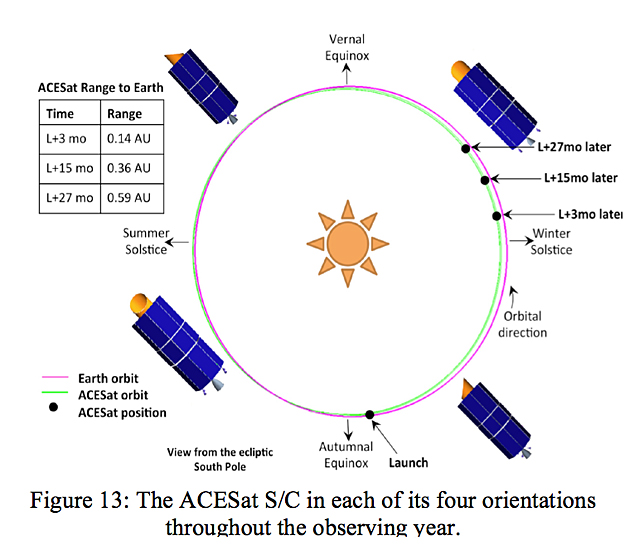Space Telescope Designed to Directly Image the Habitable Zone of Alpha Centauri

The scientific interest in directly image and identifying Earth-like planets within the Habitable Zone (HZ) around nearby stars is driving the design of specialized direct imaging mission such as ACESAT, EXO-C, EXO-S and AFTA-C.
On Wednesday, September 6, 2017, BoldlyGo Institute launched a crowdfunding campaign for Project Blue to help support the initial design phase of mission development based on the basic concepts presented in this paper. Visit their crowdfunding page for more information and to support this project.
The inner edge of Alpha Cen A and B Habitable Zone is found at exceptionally large angular separations of 0.7 and 0.4 arcseconds respectively. This enables direct imaging of the system with a 0.3m class telescope. Contrast ratios in the order of 1e-10 are needed to image Earth-brightness planets. Low-resolution (5-band) spectra of all planets, will allow establishing the presence and amount of an atmosphere. This star system configuration is optimal for a specialized small, and stable space telescope, that can achieve high-contrast but has limited resolution.
This paper describes an innovative instrument design and a mission concept based on a full Silicon Carbide off-axis telescope, which has a Phase Induce Amplitude Apodization coronagraph embedded in the telescope. This architecture maximizes stability and throughput. A Multi-Star Wave Front algorithm is implemented to drive a deformable mirror controlling simultaneously diffracted light from the on-axis and binary companion star.
The instrument has a Focal Plane Occulter to reject starlight into a high-precision pointing control camera. Finally we utilize a Orbital Differential Imaging (ODI) post-processing method that takes advantage of a highly stable environment (Earth-trailing orbit) and a continuous sequence of images spanning 2 years, to reduce the final noise floor in post processing to 2e-11 levels, enabling high confidence and at least 90 percent completeness detections of Earth-like planets.



Eduardo Bendek, Ruslan Belikov, Julien Lozi, Sandrine Thomas, Jared Males, Sasha Weston, Michael McElwain
(Submitted on 8 Oct 2015)
Comments: Presented at SPIE Optics and Photonics 2015
Subjects: Instrumentation and Methods for Astrophysics (astro-ph.IM)
DOI: 10.1117/12.2188999
Cite as: arXiv:1510.02489 [astro-ph.IM] (or arXiv:1510.02489v1 [astro-ph.IM] for this version)
Submission history
From: Eduardo Bendek
[v1] Thu, 8 Oct 2015 20:08:40 GMT (9160kb)
https://arxiv.org/abs/1510.02489
Astrobiology








